The first time I saw the Dton Yaang Naa trees I was transfixed. I was returning from a press trip to learn about the care of Elephants in the Kingdom of Thailand, when our van driver turned down Chiang Mai-Lamphun Road. Twin rows of behemoth trees flanked the narrow, twisting road as far as I could see. Thrusting my head out the window, I craned my neck up to see their crowns. Some soared to heights of 150 feet. The base of each massive trunk had been wrapped in a saffron-colored monk’s robe. These 130-year old spirit trees had literally been ordained as monks.
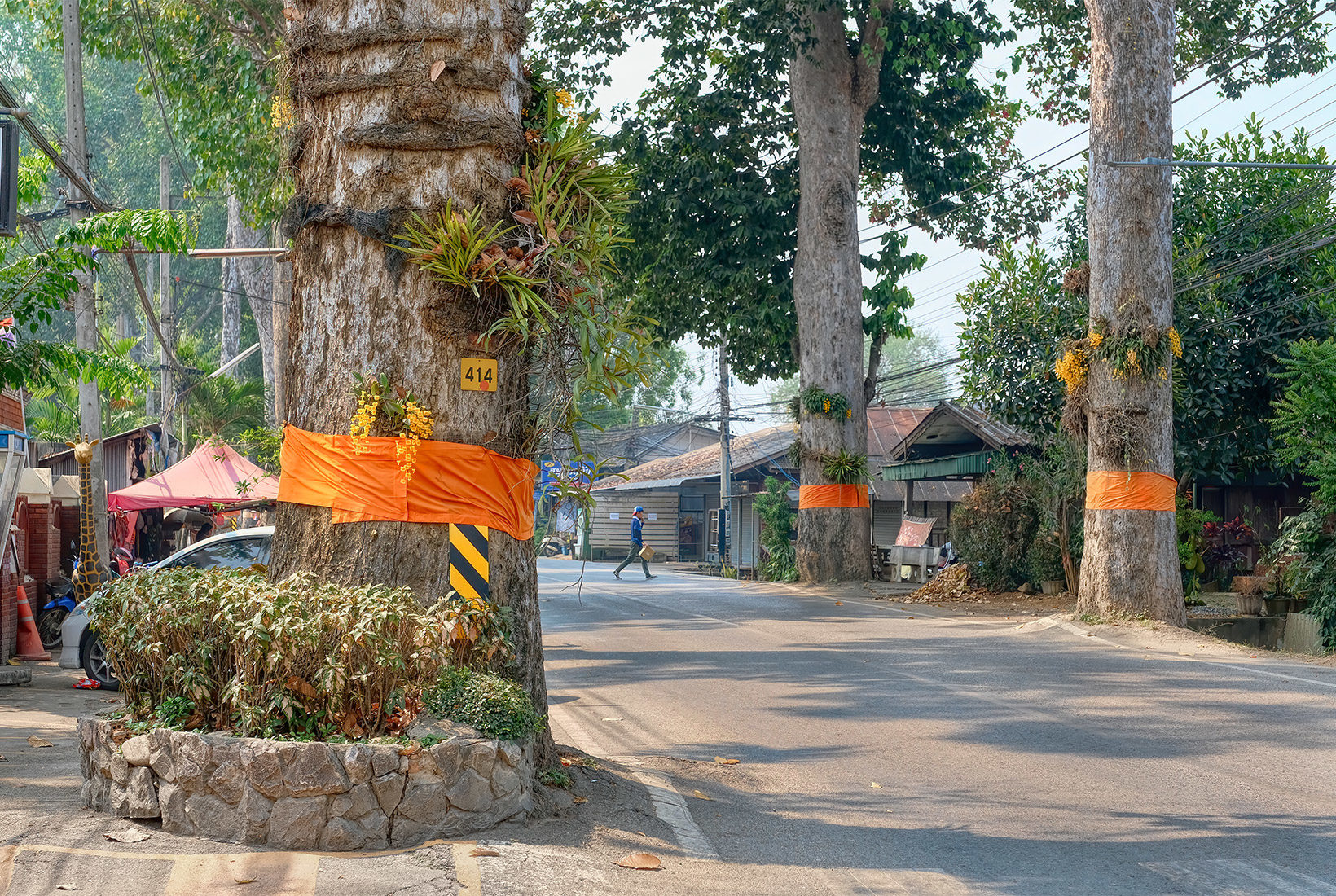
A month or so later I returned to the walk beneath them. Capturing decent photos of the Dton Yaang Naa trees was no easy task. Again and again, I darted into the heavily trafficked roadway, snapped a photo, and scampered back to the shoulder before being splattered on the pavement like a bug on a windshield. Yet even with cars, trucks, and Tuk Tuks screaming by, a sense of peacefulness pervaded the thoroughfare. It felt like these spirit trees were watching me, protecting me from harm.


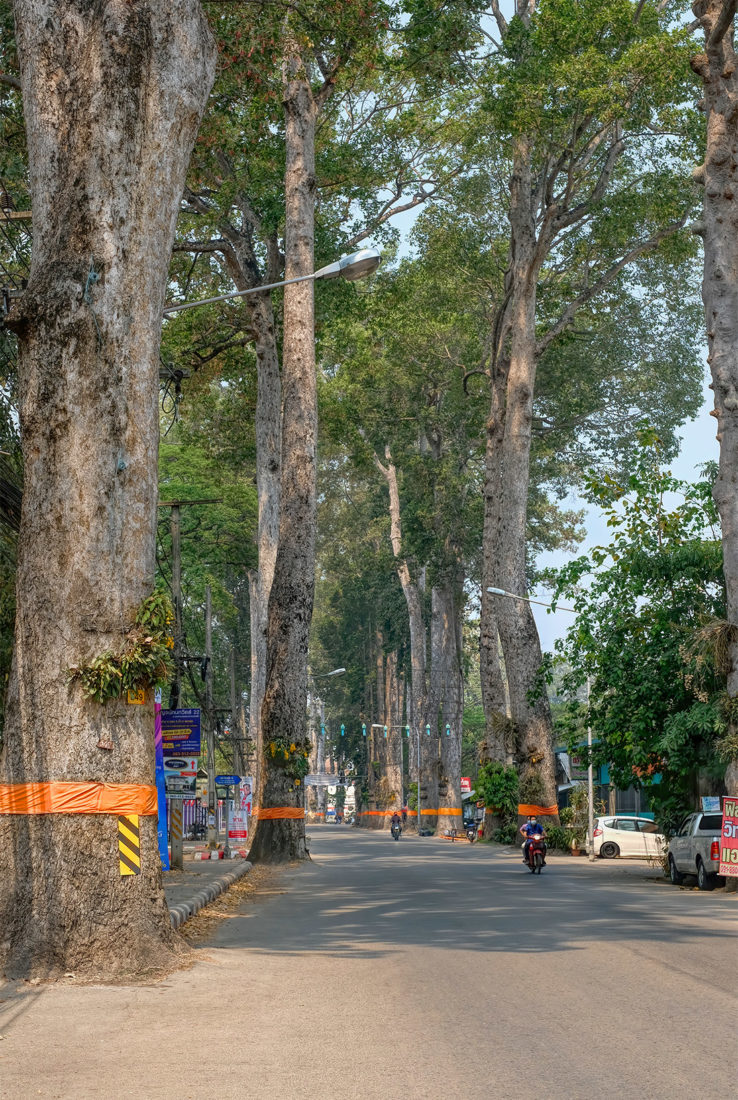
In 1882, the governor-general of the Phayab region donated the first batch of Yaang Naa trees. They were planted near Naowarat Bridge, on the banks of the Mae Ping River in Chiang Mai. It soon became evident that they were valuable for the shade they provided. Twenty-nine years later, the Provincial Office provided enough saplings to line Chiang Mai – Lamphun Road from the bridge south to the border with Lamphun Province. For decades, they provided protection from the searing tropical sun, especially for Royal retinues traveling on foot from Bangkok to inspect the northern provinces.
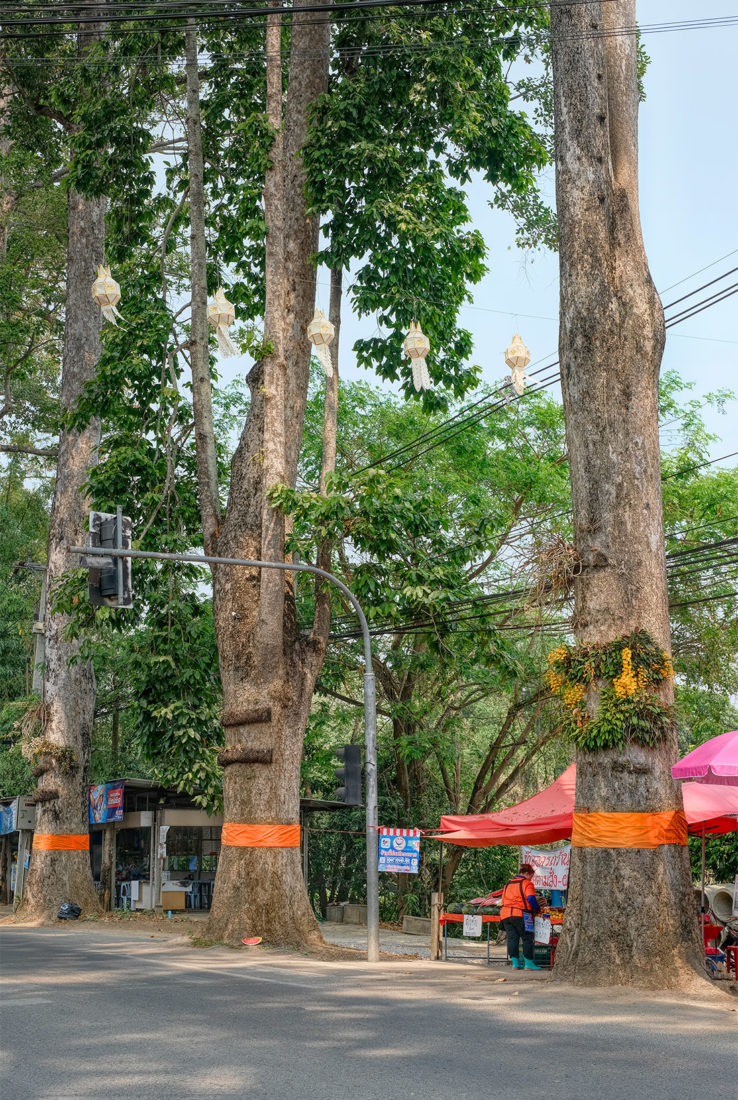
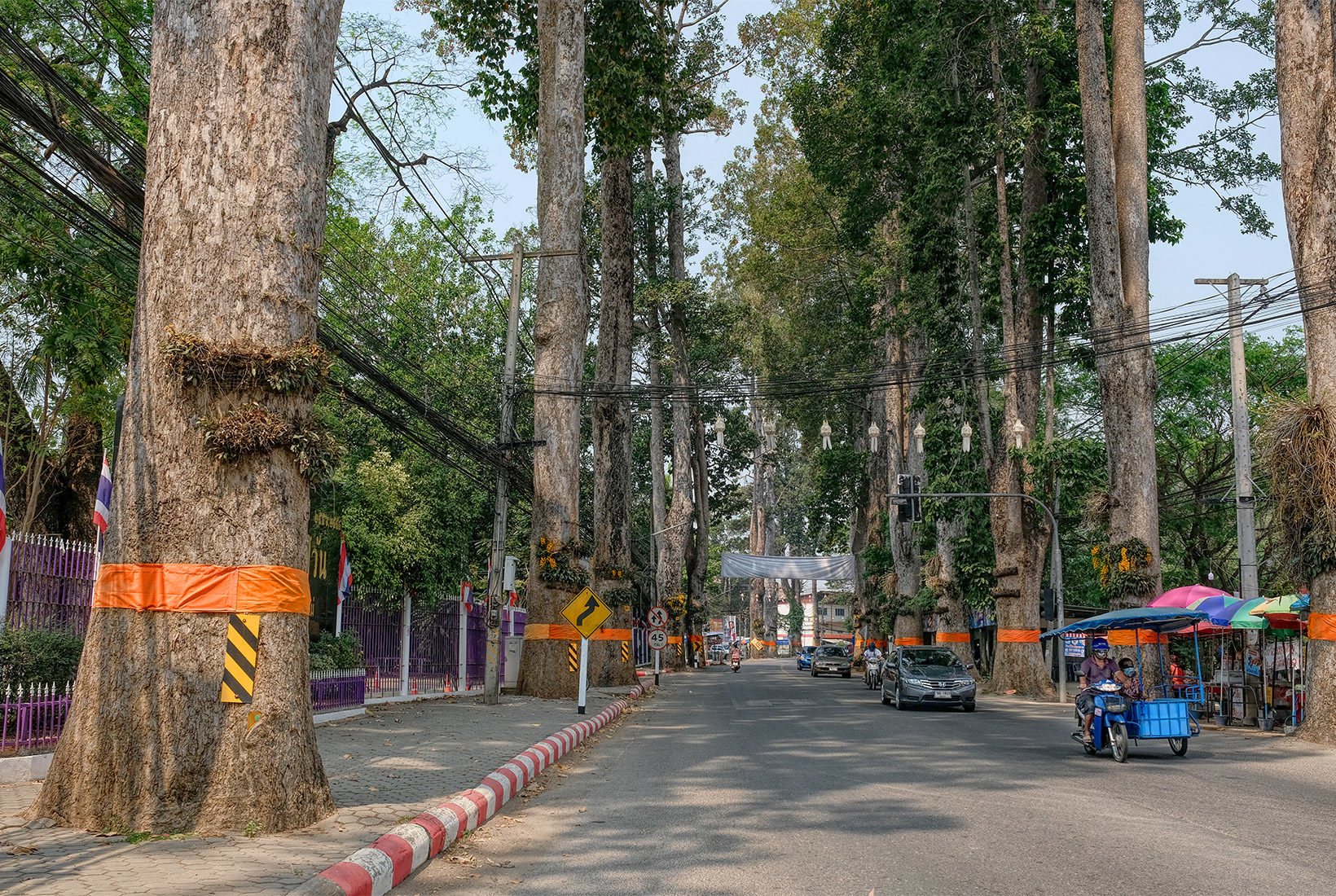
Some accounts say that 5,000 trees were originally planted, while others claim the number was 2,000. Over time, many were cut down to make way for housing and intersections. By 1991, less than 1,000 remained, and many of those were slated for removal to accommodate a road-widening project. When news of this reached the King, it is said he was not pleased. Seizing upon this opportunity, the governor of Chiang Mai Province arranged for local monks to “ordain the large rubber trees” that lined the road from Chiang Mai City to Lamphun Province (often mistaken for rubber trees, they are actually one of the 165 known species of the Dipterocarpaceae family).

The practice of protecting special trees has a long history in Thailand. The Bodhi tree is revered because the Buddha came to enlightenment while sitting beneath one in Bodh Gaya, India. Bodhi trees grow on the grounds of most every Wat in Thailand. Not only are their trunks swathed in colorful cloth, bamboo poles are placed beneath their limbs to help the tree support the weight. These so-called spirit trees (phi ton mai) are also ubiquitous in cities and villages across Thailand.
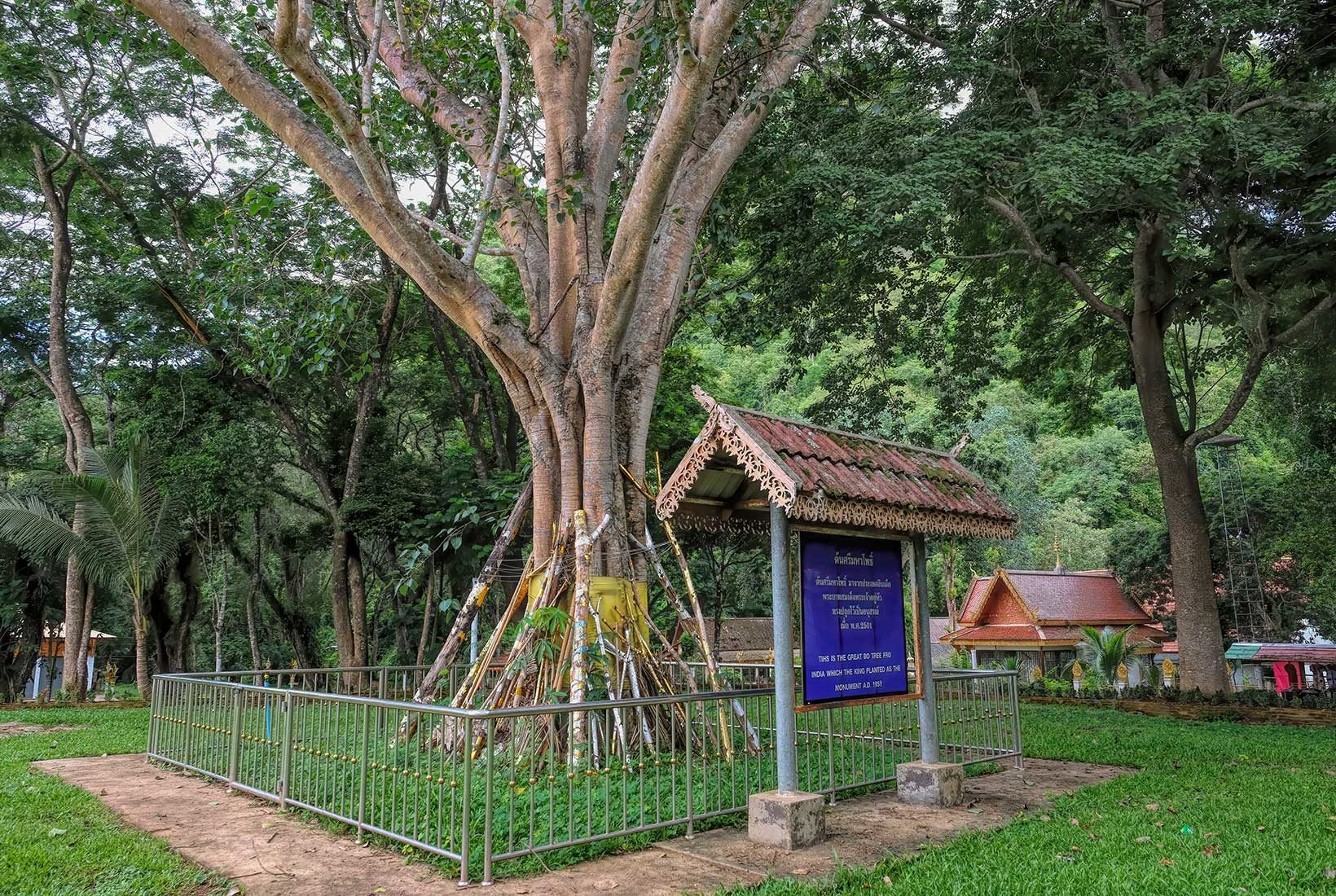

The term “spirit trees” derives from a Thai Buddhist belief that certain trees are the residence of a spirit, usually that of a deceased villager. They wrap these tree trunks in colorful cloth, construct a small spirit house at the base of the tree, and keep it supplied with candles, incense, and food offerings. Harming a phi ton mai is believed to bring misfortune, sickness, or even death upon the perpetrator. Over time, wrapping a tree in strips of colorful cloths became synonymous with protection. Today the practice is regularly employed to protect huge, old growth trees, like the one that stands at the entrance to my condominium project, seen below.

If swaddling the trunks of spirit trees has long been common practice, the concept of ordaining trees is relatively new. The first tree ordination was performed in Thailand in 1988 by the monk Phrakhru Manas Natheepitak, a member of the forest tradition in northern Thailand. These Monks follow a strict regimen. They live deep in the forest, in small wooden huts that are elevated to protect them from wild animals. They walk miles each day, foraging for food as they make their way between sites to attend Dharma talks. The forest tradition monks had seen first-hand the damage caused by deforestation. They were forced to install rows of barbed wire fencing around their compounds to deter illegal loggers.
One day, Phrakhru Manas heard a story about two highway workers who had been forced to cut down a Bodhi tree. Following its felling, they suffered great misfortune. Capitalizing on superstitions that are intricately woven throughout Thai Buddhism, he began performing ordination ceremonies on trees. Once ordained, the trees were deemed untouchable. Just three years later, the governor of Chiang Mai used the same technique to protect the Dton Yaang Naa trees on Chiang Mai-Lamphun Road.
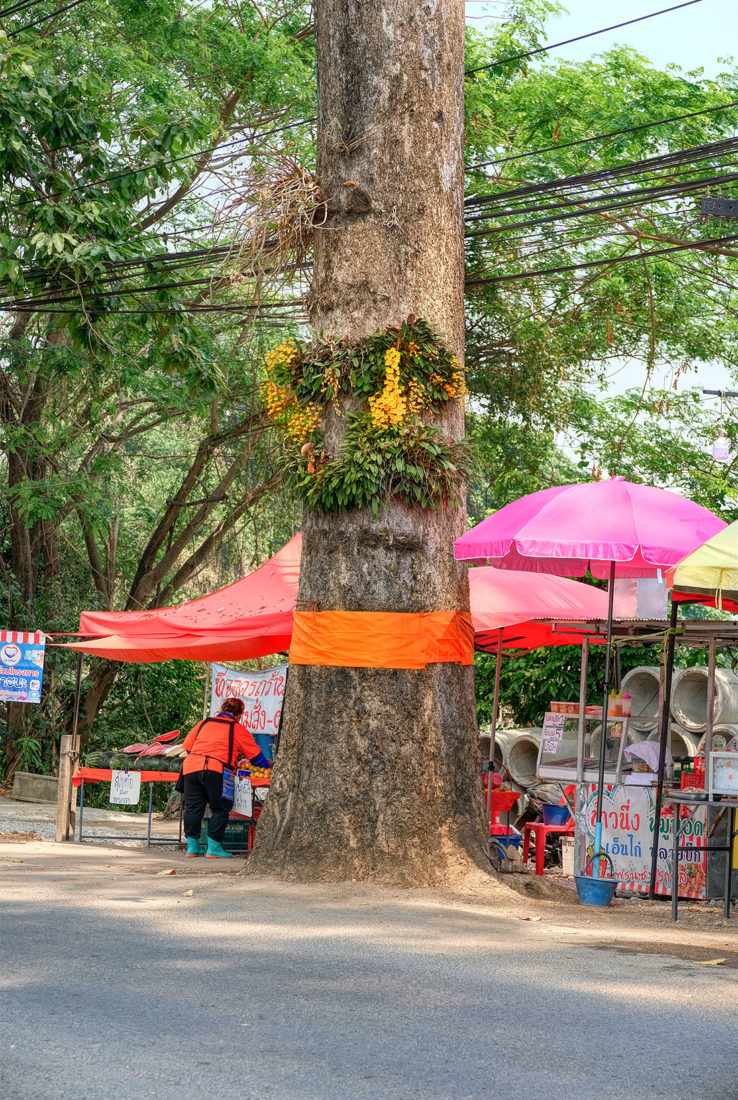
Today, members of the community tend them with great respect. Sidewalks that once entombed their roots have been torn up and the ground around them is regularly fertilized. Residents who live beneath them pay a fee of 30 baht ($1) per month to a fund that reimburses anyone who suffers damage from falling branches. The community has even attached flower boxes planted with multi-colored orchids, which burst into bloom and cascade down the trunks each spring. I walked a mile or two that day beneath their overarching crowns. I could tell they were happy. They were smiling down upon me, in all their statuesque glory.

Thank you for this article Barbara. I had read elsewhere that the tree spirits were not ancestors, but you say that the belief is that sometimes they are seen as spirits of villagers who died? Could you clarify?
Hi Joseph. It’s such a difficult question to answer, especially since these beliefs harken from a time that was centuries before Buddhism entered the scene. In many ways, Buddhism (in Thailand, anyway) is a mixture of Buddhist beliefs and animism, and the lines between the two have become very blurred. For instance, every Thai person has a shelf in their house where they make daily offerings to their ancestors, whom they believe protect them. They also have a “spirit house” outside the house, which is meant to appease the spirits of the land so that they do not wreak havoc or create mischief. But beyond that, every village has its own rituals and customs. One friend of mine, whose mother is from the Krien culture in NW Thailand, goes home to her village every year to participate in an ancestor ritual that involves building a complete miniature house for each set of grandparents, furnishing it, and having it blessed at the Wat. By doing so, they are honoring their ancestors, who then provide protection for the living relatives. Some say that natural spirits occupy the Dton Yaand Naa trees while others claim that thee spirits of their ancestors have wandered into the forest after death and taken up residence in the trees. There is no definitive set of beliefs or practices. Thailand (and Laos) are unique in their blend of the supernatural and the dharma.
http://goteilos.blogspot.com/2013/01/traden-i-saraphi-over-100-ar-gamla.html.
Hi Barbara, I see we have some excursions in common. Above my version of the trees along Lamphun road, from 2013.
Hello Gote: I just read your article about the Dton Yaang Naa spirit trees in Chiang Mai. A great account and photos too! I loved the fact that you spoke with the monks making a pilgrimage and related their story.
Hi Barbara, very interesting chat today. I see we have some excursion in common. Here my version of the trees along Lamphun road, Hw 106; http://goteilos.blogspot.com/2013/01/traden-i-saraphi-over-100-ar-gamla.html.
Hopefully you can translate to English ?.
Hi Barbara, very interesting chat today. I see we have some excursion in common. Here my version of the trees along Lamphun road, Hw 106; http://goteilos.blogspot.com/2013/01/traden-i-saraphi-over-100-ar-gamla.html.
Hopefully you can translate to English ?.
THANK YOU Barbara, firstly for the lovely chat at breakfast this morning (11th Oct 2021) and also for your link to the Hole in the Donut .com and it has given me some thrilling pictures and stories to follow & enjoy.
Perhaps see you one day search Cornwall UK for similar great photos & stories.
Hi Clive: It was a pleasure to meet you on Phuket and I enjoyed our brief chats. Hope you enjoyed your time there and visits with your son. I’ll get back to Corwall one of these days. It’s such a beautiful part of the world.
I love these trees and every time I visit Chiang Mai we ride our motorbike down this road. It is, indeed, very special. Thanks for all the background information.
You’re very welcome Rheta. Glad you enjoyed my story.
I will surely visit Thailand & want to see those beautiful location. Thank you for providing such a good information.
You’re very welcome Shweta. I hope you get to visit Thailand someday soon.
Thank you for sharing this, Barbara. I had never heard of these spirit trees to date. Such beliefs always draw my attention, and I like to visit such places in person. I hope to visit these trees and click a few photos too.
Thanks so much for your comment Anukrati. I hope you make it to Chiang Mai to see them in person.
I have lived here for years but didn’t know much about these amazing trees; thanks for the info Barbara. Chiangmai-Lamphun road is always busy but you managed to avoid all the traffic to capture those majestic trees. Wow!!
Hi Patrick! Gosh, they’re just a short drive away for you. Hope you get a chance to see them in person. Happy to take a drive down with you one day 🙂
Barbara, wonderful article! I have shared it with friends who also loved it. The comment above was very informative, too. We are so fortunate to live in such a remarkable place. Thanks for helping me appreciate and understand it more.
Hi Christine: I’m SO glad you enjoyed this story! I just loved these trees and could hardly wait to share the story with my readers.
Hi Barb:
Thanks so much for sharing these stories and photos from Chiang Mai! What amazing trees! I love them! Not too many adventures for me lately. I suffered another concussion a few weeks ago and I am pretty dizzy! Take care, Laura Lee
Hi Laura Lee. So sorry to hear about y our concussion. I’ll send energy for your quick recovery. xo
It’s always good to hear a succests story about trees. Thank you!
You’re welcome Sherry. Thanks for your comment.
So grateful for the sharing of all this info. Trees are very conscious beings. As we all know there would be no llfe on this planet without them. The presence in these trees is so beautiful. Thank you so much for all that you share. Everyone is so blessed by the consciousness you share. Thank you forever!
Hi Maraine: Thank you so much. I’m delighted you enjoyed my article. Anything that saves trees is great in my view, and I love your comment about trees having consciousness. It’s true! They’ve now demonstrated that trees communicate like a community, by using their network of intertwined roots.
Ordination seems the wrong word because the Buddha laid down precise requirements for ordinations. Do the Thais use the same word for monk ordinations as tree ordinations?
I think the tree ordinations must be simply blessings, like the banners on boat prows that have been blessed by monks.
Hi Bill:
Technically, you are correct. Sangha law restricts ordinations to human beings. Indeed, after Phrakhru Pitak performed the first ceremony there were calls for him to disbrobe because he had violated Sangha law. Mostly, this was a smear campaign conducted by the military and logging industry. He was labeled the “Russian monk” and “communist monk.” However, support for his program had the overwhelming support of the Thai people, NGO’s, and eventually, the government. Plus, he had been clever enough to involve the Sangha leadership in the effort from the beginning, so he encountered no real resistance from them.
Tree ordination is an invented tradition. Although the format of his ceremony was that of an ordination, nobody believed the tree was actually a monk. Phrakhru Manas chose the word ordination to give the ceremony more weight. He said, “It’s not true Buddhism to conduct such rituals. But in the villagers’ beliefs they respect the Buddha and fear some of his power. In general, villagers also believe in spirits. Therefore, we set up a shrine for the guardian spirit together with the Buddha image.” Today, Tree ordination is widely accepted throughout Thailand. Its acceptance was no doubt helped greatly when, in 1997, the king officially endorsed the practice and asked Thai citizens to ordain 50 million trees in honor of the fiftieth anniversary of his accession.